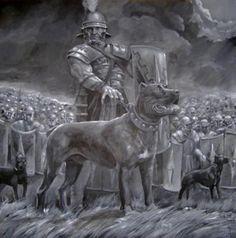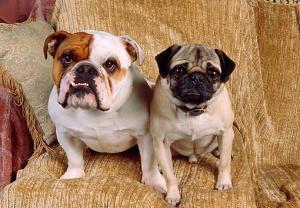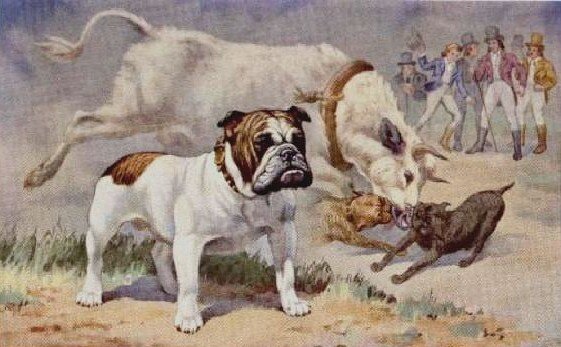English Bulldogs – Bred to Companionship
We’ve talked in previous posts how bulldogs have had an adventurous and ferocious past as bull-baiting dogs. Now, though, they are one of the most docile dogs in the world and beloved as the family dog and companion. But, how did this happen in a short span of about 150 years?
Most people know the answer is through breeding. Take for example the philosophy of bulldog breeders. Breeders will keep the best of their litters in order to breed further generations. This ensures that the best qualities we’ve come to love in bulldogs are replicated over time – enabling the breed to improve on those qualities as well as maintaining the breed and preventing extinction.
However, our real question is how did we go from fearsome to cuddly? The bulldog of today maintains much of the physical characteristics of past bulldogs, but little of the aggressive nature.
 Bulldogs are thought to come from the now extinct Alaunt dog breed. Alaunts were larger short-haired dogs commonly used throughout Central Asia and Europe. As is customary among ancient breeding the provenance of the bulldog is a matter of speculation, with some historians arguing that the bulldog is the parent breed to the Mastiff, while others say both breeds came from the Alaunt. However, despite their historical debates bulldogs were larger and stronger than our current breed. Due to their strength and physical stature they could be used for many types of duties from farm labor to warfare. By the 1800’s bulldogs grew to popularity in the sports bull-baiting, hence the name bulldog. Due to their physical strength, aggressive nature, and unique physical features bulldogs were excellent hunters and fighters.
Bulldogs are thought to come from the now extinct Alaunt dog breed. Alaunts were larger short-haired dogs commonly used throughout Central Asia and Europe. As is customary among ancient breeding the provenance of the bulldog is a matter of speculation, with some historians arguing that the bulldog is the parent breed to the Mastiff, while others say both breeds came from the Alaunt. However, despite their historical debates bulldogs were larger and stronger than our current breed. Due to their strength and physical stature they could be used for many types of duties from farm labor to warfare. By the 1800’s bulldogs grew to popularity in the sports bull-baiting, hence the name bulldog. Due to their physical strength, aggressive nature, and unique physical features bulldogs were excellent hunters and fighters.
Whoa! Whoa! Whoa! Hold on for a minute here! I know what you’re thinking. That little ball of muscle rolling around on the couch with my toddler while watching a football game is aggressive? It used to be a fighter? Not a chance!
Well, it’s true, but again how we got to our current breed is up for debate and speculation. A common belief is that our current breed came directly from the bull-baiting breed of the 18th and early 19th century. The process of carefully breeding the bulldogs by a few small bulldog lovers in England who wanted to develop a more docile breed by selective breeding is a possibility. Traditionalists will argue that these early dog clubs kept purity in the breed and over multiple generations of dogs had bred out the aggressive nature the dogs were once prized for. Yet, another theory is that the current bulldog is a cross-breed of pugs, and the bulldog. This created a muscular and broad shouldered dog, with the docile and playful nature of the much smaller pug.
 Pugs have for centuries been a favorite throughout Asia and Europe, especially regarding royalty and other affluent families. Their gentle nature made them excellent companions and they embody the desired traits of their owners – loyal, brave, and affectionate. Throughout China they were bred for these reasons for the ruling families.
Pugs have for centuries been a favorite throughout Asia and Europe, especially regarding royalty and other affluent families. Their gentle nature made them excellent companions and they embody the desired traits of their owners – loyal, brave, and affectionate. Throughout China they were bred for these reasons for the ruling families.
However, the curiosity surrounding a bull-baiting crossbreed between a pug and older bulldog breed comes from several modern similarities:
• Shorter and wider body
• Distinctively shorter muzzle
• Temperament: playful, affectionate, docile, and often lazy and cuddly.
These traits while very much resembling a pug, have less distinction among past bulldogs which passes the question would it have been possible to breed out the centuries or millennia of aggressive behavior bulldogs once had in such a short time? Critics of the pug theory argue yes, it is, with the premise similar to the statement by John D. Jackson in a 1997 interview, “I do not believe that a 15-pound Pug was ever crossed in the 17th or the 18th century with a 100-to-120-pound Bulldog. I do not believe that this was possible in those days, since they did not know artificial insemination.” Mr. Jackson also cites that bulldogs have never been reported as having a black mask, and their tails are twisted differently.
However, we look at these three distinctive time for the bulldog – Alaunt, Bull-baiting, Modern – the debate still rages on much more fiercely than the affection bulldog we know and love today. Still, curiosity is both the success and plague of man. So, we pose the question to you – Do you think our modern bulldog was bred to its smaller stature and demeanor by aggressive breeding in the late 19th and early 20th centuries? Or, do you think breeding more aggressive bull-baiting bulldogs with pugs created our current breed?







